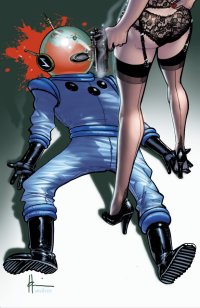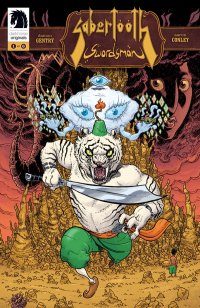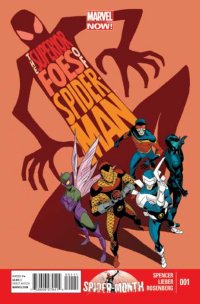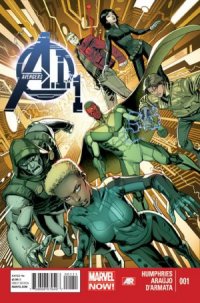SATELLITE SAM #1 ($3.50, Image)
By Adam Prosser
We live in an age where all our pop culture is ultra-slick, refined, polished and above all, expensive. It’s fairly rare to see a mainstream movie in theaters that didn’t cost tens of millions of dollars, and the big blockbusters regularly exceed $200 million, often for no other real reason than sheer momentum. Major video games have similarly bloated budgets, and the more costly TV shows (Game of Thrones, for instance) are now trying to compete with movies in terms of production value, and sometimes succeeding. Comic books are one medium that’s mostly avoided this, mainly because the only way to really bust the budget on a comic book is to pay creators huge salaries based on their value, and BWAHAHAHAHAHA sorry I couldn’t finish that sentence.
One side effect of all this profligacy is that the entertainment produced has to play it safe and deliver something that the mucky-mucks KNOW will provide a hit; there’s little room to experiment with something more offbeat, the way that there is when less money is at stake and the people behind the scenes are flying by the seat of their pants. For a comparison, look at how television has evolved. Nowadays we tend to think of TV shows as little movies serialized and broadcast over a period of months and years; but there was a time, back in the very early days of television, when you could legitimately claim that the medium closest to TV wasn’t film, but rather, theater. Sets were built more like stages, and the shows were recorded in front of an audience, and sometimes even broadcast live. (A remnant of this tradition survives even today with the traditional three-camera sitcom.) Sure, this form of broadcasting was often laughably threadbare and cobbled-together, but there was an energy and an imagination offered by doing things in this manner. In fact, creativity was virtually mandated by how tricky it could be to deal with the myriad problems that would arise from a live broadcast, not all of which were technical in nature.
Matt Fraction and Howard Chaykin’s new creator-owned comic, Satellite Sam, gives us a glimpse into this now-lost world, and it’s electric. The story takes place behind the scenes of a low-rent 50s children’s show in the Captain Video mold, where the star’s gone missing as the time for live broadcast nears–presumably because he’s holed up with some floozy across the street. As the chaos mounts and the backstage crew, which includes the actor’s own son Michael, scrambles for creative ways to work around his absence, the reasons for said absence are revealed to be a great deal more alarming than everyone assumes: turns out he’s been murdered, and with Michael stepping in for him as a last-minute fix, he’s now thrust into the spotlight.
Fraction and Chaykin–a rising star and a living legend, respectively–both have a strong grasp on how to convey energy through the medium of comics, and in fact their methodology here suggests that they’re attempting to emulate the same slapdash, live-without-a-net feeling as their subjects. The comic is in black and white and loosely inked, giving it a rough, sketchy feeling. I don’t know if the two set themselves some kind of tighter time limit for the production of this comic, but it feels like they might have done so. Even if they didn’t, fans of these two creators will know that they’re drawn to formal experiments of the kind that makes the story leap off the page, and which is perfect for capturing the feeling of controlled (or even uncontrolled) chaos of a live television broadcast. Even without the noir elements, which don’t really make themselves apparent until the end of the story anyway, this makes for a wonderfully fresh and original comic, something unlike anything else on the stands right now. The golden age of television may be over, but comics are one medium that keep a little of its scrappy spirit alive.
Rating: 




Out of a Possible 5 Stars
 Sabretooth Swordsman 1-5 ($0.99 each, Digital Only, Dark Horse)
Sabretooth Swordsman 1-5 ($0.99 each, Digital Only, Dark Horse)
by D.S. Randlett (@dsrandlett)
Brandon Graham’s revamp of Prophet may prove to be the most important series of the second decade of the twenty-first century, if it hasn’t already. Graham’s aesthetic, greatly informed by Japanese and European comics, has permeated that mainstream series from the beginning (and judging by its popularity and Image’s ever-growing influence on the comics market, it is most definitely mainstream). The storytelling is often bizarre, with a loose and loping feel full of brief digressions into an intentionally disturbing eroticism. It appears Graham is at the vanguard for that aesthetic if not its inventor, as more and more accomplished titles that share his artistic outlook are surfacing along with a renewed interest in popularity for some of Graham’s own older creations like King City and Multiple Warheads. As an artistic and storytelling aesthetic, this style is often obtuse or uncomfortable, and the stories rarely speak to any solid sense of theme. But then, I think that that’s part of the point, to explore those feelings of discomfort and sexuality within the soup of influences swirling in the creators’ heads.
I love Graham’s work, so when he recommended Damon Gentry and Aaron Conley’s Sabretooth Swordsman on Twitter, I knew that I had to check it out.
Happily, it fits on the bookshelf right next to Graham’s work while maintaining its own sense of identity. For one, despite a lot of the story’s dark or disturbing undertones, it comes from a place much less jaundiced than Graham’s worldview. Here we’re in a fantasy world (which fits right in with Dark Horse’s pulp fantasy raison d’etre) that has its foundations in the Arabian Nights, or rather illustrations of the Arabian Nights filtered through a Ren & Stimpy or Spongebob lens. Gentry and Conley use that reference for a starting point, but quickly start pulling visual references out of their bag of tricks with anarchic glee. This could be irritating, but luckily the creative team always uses this device in the service of evoking explicit emotions or vibes, and they are nearly always on point. After all, a big theme in this story is embarrassment, and this type of storytelling allows Gentry and Conley to attack that from every angle so that it is at turns sad, ridiculous, or joyful.
Conley’s art (I suspect with some very major idea assists from Gentry) is quite something to behold. It’s bursting with disgusting, veiny detail. A lot of the creatures that show up lack things that are identifiable as faces, or else their facial elements are dispersed throughout their grotesque forms. Entire bodies crease and bulge the way one’s face does in the throes of extreme emotion, and it works to convey the characters’ extreme +1 emotions. It also works at simply being really gross, and really funny.
All that said, Sabretooth Swordsman is definitely a “your mileage may vary” book. A lot of the book’s content, most of which is worn on the surface, is really easy to miss in the hyper-detailed art. It’s easy to see how someone could feel like this book is an exercise in pointlessness. But, as with a theme park ride, that pointlessness might be the point. Sabretooth Swordsman might very well be a carnival ride (something akin to the boat from WIlly Wonka and the Chocolate Factory, actually), but it’s a ride through so many different connections and ideas that will leave you either baffled or delirious. Only one way to find out.
Rating: 




Out of a Possible 5 Stars
The Superior Foes of Spider-Man #1 (Marvel, $3.99)
Avengers A.I. #1 (Marvel, $2.99)
By Jeb D.
While Disney’s purchase of Marvel has certainly resulted in the expected multi-media and merchandising explosion of familiar brands (Avengers, X-Men, Spider-Man, etc.), it’s actually surprised me that the comics division has managed to maintain a few side alleys where writers and artists seem to have the freedom to innovate, experiment, and challenge readers’ preconceptions of what constitutes a corporate superhero comic. In the wake of the successes of Hawkeye and Young Avengers comes a pair of titles that manage to tell engaging stories while featuring characters most of whom we’d think of as C-level (at best).
The Superior Foes of Spider-Man really doesn’t tie explicitly into the current “Superior” storyline; Spider-Man mostly exists offscreen, having repeatedly beaten the tar out of the “Foes” of the title. Those Foes are former members of the Sinister Six, led by Boomerang, who’s trying to step up to the big leagues by fashioning Speed Demon, The Shocker, The Beetle, and Overdrive into his own crime syndicate, while still in prison. While there are some structural similarities to DC’s Secret Six, the tone of Superior Foes owes more to Elmore Leonard, and to the “what Marvel characters do on their day off” sensibility of Matt Fraction and David Aja’s Hawkeye. Boomerang is a typically Leonard-like smalltimer with delusions of grandeur: he has the same tunnel-vision logic that refuses to acknowledge the intractability of obstacles (like the intellectual limitations of his putative allies, to say nothing of his own). And, like many a Leonard character, he’s easy for readers–and enemies–to underestimate: he’s not as dangerous as he thinks he is, but that doesn’t mean you can turn your back on him.
Writer Nick Spencer mingles scruffy urban noir with a nicely skewed sense of humor, and Boomerang’s narrative voice has just the right touch of tough-guy snide (“Together, we’re the new Sinister Six! And, yes, I am aware that there are only five of us. Thank you.“). Though I suspect the series will be more plot-driven as it moves along, this first issue sets the tone with wry humor, and touches of slapstick. Steve Lieber (Whiteout) was one of the artists on the Hurricane Sandy issue of Hawkeye, and while his layouts here tend more to the conventional than Aja’s, he does have a similar sense for a lived-in urban setting. I don’t know if a book like this can find an audience without dragging in Spidey, or other big guns, on a regular basis, but for however long we have it, Superior Foes of Spider-Man seems likely to be a real treat.
 Avengers A.I. grows out of Mark Waid’s A.I. issue of Age of Ultron: after everything that’s happened since his creations nearly destroyed humanity, it’s not surprising that Henry Pym would start to seem even more unbalanced than usual, but I’m not sure that writer Sam Humphries hasn’t dosed him with a few more crazy pills than even that would warrant. In a SHIELD interrogation room, Pym rattles on about his contributions to science, darts quicksilver-like around the time-warping possibilities of the Age of Ultron, snarks about his own genius, and only finally addresses the dangers that his A.I. experiments pose when Captain America pops in to inquire about The Vision… who, as it happens, is currently running a legacy program to upgrade himself in ways that Pym would never have predicted. Nonetheless, Cap’s going to deputize Pym to lead yet another team of Avengers, this one centered around A.I. beings: besides The Vision, we get ex-Runaway (and Ultron’s kid) Victor Mancha and Pym’s reconstructed version of one of Dr. Doom’s Doombots.
Avengers A.I. grows out of Mark Waid’s A.I. issue of Age of Ultron: after everything that’s happened since his creations nearly destroyed humanity, it’s not surprising that Henry Pym would start to seem even more unbalanced than usual, but I’m not sure that writer Sam Humphries hasn’t dosed him with a few more crazy pills than even that would warrant. In a SHIELD interrogation room, Pym rattles on about his contributions to science, darts quicksilver-like around the time-warping possibilities of the Age of Ultron, snarks about his own genius, and only finally addresses the dangers that his A.I. experiments pose when Captain America pops in to inquire about The Vision… who, as it happens, is currently running a legacy program to upgrade himself in ways that Pym would never have predicted. Nonetheless, Cap’s going to deputize Pym to lead yet another team of Avengers, this one centered around A.I. beings: besides The Vision, we get ex-Runaway (and Ultron’s kid) Victor Mancha and Pym’s reconstructed version of one of Dr. Doom’s Doombots.
I have the sense that Humphries is going for something on the order of Nextwave here, with Victor more interested in coming up with a cool superhero name than anything else, while the Doombot rages about being forced to join the team (after Pym cheerfully introduces him, Doombot snarls “My most fervent wish is to crush your pathetic freedoms beneath my boots.“), all the while having Pym act loonier and loonier. But where Ellis and Immonen kept their satirical knives sharpened the entire way, Humphries and artist Andre Lima Araujo (at least in this first issue) seem more interested in just grafting a bit of yuk-yuk-yuk onto a standard superhero adventure, and Araujo’s cheerfully cartoony pencils emphasize the wacky at the expense of anything that might carry weight. It’s an amusing idea for a one-off, but a continuing series that hinges on unhinging such a core Marvel U character as Henry Pym is likely to run out of steam sooner rather than later.
Superior Foes of Spider-Man #1: Rating: 




Out of a Possible 5 Stars
Avengers A.I. #1: Rating:





Out of a Possible 5 Stars